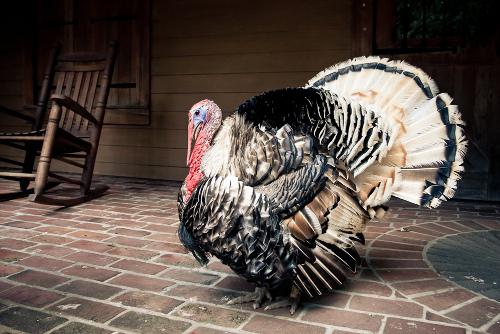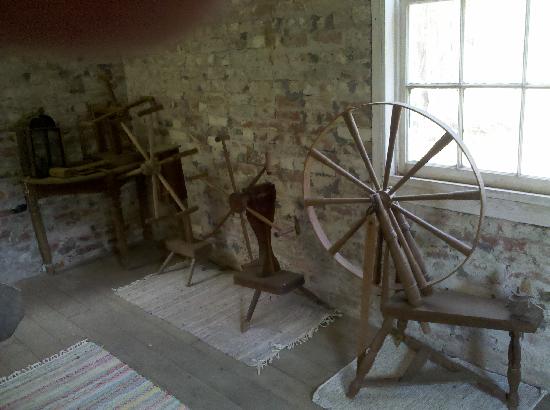From The Advocate, "A Colonial Christmas — with wassailing, too: Event takes participants back to 1810," by Janice Lovett (Special to The Advocate), on 3 December 2012 -- ST. FRANCISVILLE - The lyrics of the classic Christmas carol - "Here we come a-wassailing, among the leaves so green..." captured the spirit of the 1810 Colonial Christmas celebration held Saturday at Oakley Plantation House on the Audubon State Historic Site just outside St. Francisville [Louisiana].
A handful of early-bird townsfolk and travelers arriving well before noon were treated to the sight of costumed staff members making preparations for the evening's festivities.

Slave Cottages/Cabins
Bustling around the grounds in period clothing, the tour guides, re-enactors and staff made ready for a traditional 1810 Christmas that was to occur during the night: a candlelight tour of the house, storytelling around a bonfire, roasted chestnuts, vintage dancing, and food of that era.
With flushed face and bare feet, head cook Kari House stoked the fire in the open hearth of the outbuilding kitchen as she pulled fresh-baked bread from an iron kettle.

"This area of the Spanish colony was settled by the English, Irish and Scottish," she said. "So the traditional Christmas fare was not Cajun or Creole, it was ham and turkey and mashed potatoes and cranberry sauce. And wassail."
Wassail - a warm and spicy alcoholic beverage - was imbibed in England by chilled 19th century carolers as they tramped from orchard to orchard, singing blessings to the trees for a bountiful new year.
Cooking on open hearth

But cooking in bare feet near an open hearth - is that traditional, too? House laughed, "Probably so. The head cook was the best-treated slave on the plantation, yet she and her helpers usually had only one pair of shoes. And those were saved for church."
Kari's husband, John House, manages the Audubon site for the Louisiana Office of State Parks.
This was his 10th Colonial Christmas. He explained choosing 1810 as an emblematic yuletide year was no accident.

"For a brief period in 1810, residents in the surrounding area rebelled against Spanish rule and became an independent nation," he said.
"They called themselves the West Florida Republic. That lasted about three months. But in December, the U.S. Army marched up from New Orleans, said ‘No,' and annexed us into a U.S. Territory."
In a nod to that military history, an all-volunteer group of militia re-enactors set up camp in the grassy field across from Oakley House.
With their costumed wives and children looking on, they wheeled a naval gun mounted on a field carriage into the clearing, a common warfare practice of the time.
Under the direction of Park Ranger Daniel Wilcox, the crew fired the cannon with a thunderous "boom" that roared through the woods, shaking the 200-year-old house.
Audubon paintings
Built in 1801, for a brief time the house sheltered noted artist and naturalist John James Audubon, hired to tutor the owner's daughter.
"It was here that Audubon painted 32 local birds for his famous illustrations," said newest ranger and tour guide, Susan Caston.
A lasting impression provided by the tour was the simplicity of holiday decorating used during the Federalist period: garlands of cypress fastened with red bows over the gallery, boughs of pine festooned with apples and lemons on the mantel, sprigs of red berries in a vase.
But no Christmas trees. "Trees came later, during the Victorian period," Caston said.
The natural décor pleased retired art teacher Lorraine Liebert, of Lafayette, who said she was looking forward to sampling the wassail later that evening.
"I visited one of my daughters in Europe, where they drink a lot of wassail during the holidays.

As a special treat for those who could not attend the Colonial Christmas celebration at Audubon State Historic Site this year, Kari House shared her Wassail recipe:
Wassail Recipe
1 gallon apple cider
2 cups cranberry juice
½ cup honey
½ cup sugar
2 oranges
Whole cloves
1 apple, peeled and diced
Allspice
Ginger
Nutmeg
3 cinnamon sticks or 3 Tbs. ground cinnamon
½ cup to 1 cup brandy (optional)
Set your crock pot to its lowest setting and pour in apple cider, cranberry juice, honey and sugar. Stir as it heats so honey and sugar dissolve. Stud oranges with cloves and place in the pot (they'll float). Add diced apple, allspice, ginger and nutmeg to taste - usually a few tablespoons of each is plenty. Snap the cinnamon sticks in half and add to mix.
Cover pot and simmer 2 to 4 hours on low. Add brandy about 30 minutes before serving. Enjoy! (source: The Advocate)



Really Nice Post..Beautiful..
ReplyDeleteThanks! Merry Christmas!
Delete